It’s common at advocacy-oriented conferences to hear the latest horrible stats about how bad things are and how it’s up to the great work of advocates to charge into a new era and change the world.
At the Safe Routes to School National Conference being held in downtown Portland this week, attendees just got all fired up from a keynote by Richard Jackson, and M.D. and Professor of Environmental Health Sciences at UCLA.
“…all I’ve heard is that it can take up to 5 or more years to put in a crosswalk and make the necessary infrastructure changes so that the kids who live 1/4 mile away from school will be able to walk and bike.”
— From a comment yesterday made by a woman in Beaverton
He implored the crowd to work harder in tying transportation reform to the health agenda and spoke with great urgency that work being done with Safe Routes programs are essential to reversing dire trends in obesity, climate change, and so on.
In addition to health, another major theme at the conference this year is school siting. A major reason that the percentage of kids who walk about bike to school has plummeted in the last four decades is that schools are being built in locations that make biking and walking nearly impossible.
One reason for this is an attempt by districts to save money and buy cheap land on the outskirts of town. There is also a trend toward mega-schools. In a session yesterday we learned that from 1968-2001 there were 1,000 less schools and 2 million more students. National Safe Routes leaders are pushing for flexible, smaller, neighborhood schools where students can have more transportation options. They are also working to teach school boards that there is no minimum acreage requirement for new schools (some incorrectly believe that one exists).
With all of that swirling around my head, a comment came in yesterday that made these challenges and stats very real. Someone named “Elaine” left a comment about her experiences trying to improve the transportation environment around a new public school in Beaverton (about 8 miles west of Portland).
She wrote (emphasis mine):
“As a PE teacher helping to open a new public school in Beaverton, I find myself up against a slightly different battle. Our school lies just north of a busy Washington County Rd with a 45 mph speed limit, and within a new housing development (which does have good sidewalks). The sidewalks and bike lanes along this main road (south of the school) are limited, but many of the neighborhoods that will feed into the school have great walk and bikeability.
It’s really just this one busy road that’s the crux. There is no designated crosswalk to get kids across this busy intersection and into the neighborhood where this school is located.
I’ve tried connecting with Safe Routes, the BTA, Washington Co DOT, and our Districts’ transportation department. Unfortunately, all I’ve heard is that it can take up to 5 or more years to put in a crosswalk and make the necessary infrastructure changes so that the kids who live 1/4 mile away from school will be able to walk and bike.
For the forseeable future and starting this September almost 450 of our 500 kids will be bused from 1/4 mile away for the next few years. It could cost the district so much more in transportation costs then it will to install some crosswalk signs.
I’m frustrated more with the planning side of this, when areas get developed, and why sidewalks and crosswalks are not mandated by a town, city or county before construction takes place. It’s a safety issue and a public health issue.
We do have some enthusiastic parents at our school who are also passionate about walking and biking to school. I hope they can make some noise and get things moving along faster than 5 years.”
Elaine touches on many issues that are at the heart of the Safe Routes movement today. Bus transportation has for years been considered the only other option than private car to get kids to school. But buses are far from an ideal option: They pollute, they create a traffic hazard, and they don’t do much to combat the obesity epidemic. At a session yesterday, the State Network Coordinator for the Safe Routes to School National Partnership told attendees they should “think outside the bus”.
Elaine’s story also brings up the importance of “complete streets” policies and how they might be connected to Safe Routes. The Bicycle Transportation Alliance is well aware of this issue. Last legislative session they introduce a bill (SB 276) would would have required school districts to “consider effect of school site selection on transportation costs to school district and to families of school children”.
The issue of network connectivity is also at play here. Washington County has a lot of off-street trails, but they rarely connect directly with commercial areas. I experienced this first hand when I took a ride out there back in May.
Elaine is up against a lot. For years, battles like hers have been waged by local activists and advocacy organizations. In Portland, we’re fortunate that many of our City engineers and planners are also advocates who understand and care deeply about these issues.
But what about Beaverton and rest of America? It’s time the federal government started making these issues a higher priority. Hopefully we see major reform around these issues in the new transportation bill; that is, once the Obama Administration is done with other, more important things.


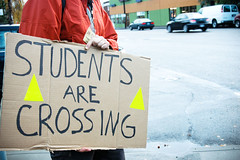
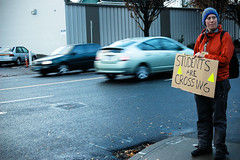
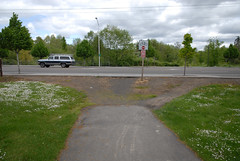
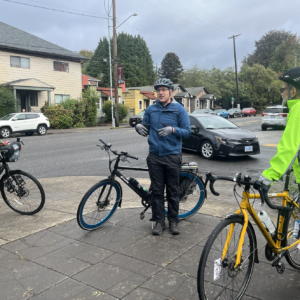

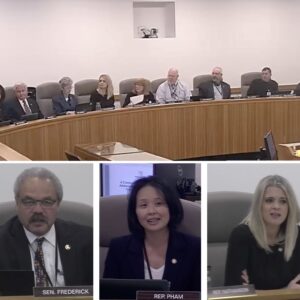

Thanks for reading.
BikePortland has served this community with independent community journalism since 2005. We rely on subscriptions from readers like you to survive. Your financial support is vital in keeping this valuable resource alive and well.
Please subscribe today to strengthen and expand our work.
This hits home! “think outside the bus”.
This part of Elaine’s comment…:
“I’ve tried connecting with Safe Routes, the BTA, Washington Co DOT, and our Districts’ transportation department. Unfortunately, all I’ve heard is that it can take up to 5 or more years to put in a crosswalk and make the necessary infrastructure changes so that the kids who live 1/4 mile away from school will be able to walk and bike.
For the forseeable future and starting this September almost 450 of our 500 kids will be bused from 1/4 mile away for the next few years. It could cost the district so much more in transportation costs then it will to install some crosswalk signs.”
…should ring some bells. Really, how hard is it, and how much money would it cost to send a small crew out to set up a temporary standing or overhead wire strung crossing light, and pavement markings to go along with it? Sounds like about 4-5 days work at best, maybe less. Cost for labor, equipment, poles, wire, asphalt, paint…I don’t know…say…$20,000-$30,000 or less?
Seems like this kind of thing is routinely done for road construction projects. Do it for schools that need a short term solution while the years long red tape for a permanent installation runs its course.
It is a sad trend here. Back in the day, there was a crosswalk with a guard on Walker Road by Barnes Elementary and Holy Trinity School. It went away. Because it wasn’t safe! There is a traffic light for students to get into William Walker Elementary. Why not Barnes?
They recently paved a new trail over by Tualatin Valley Nature Park which goes to the street twice, and the sidewalk is marked “No Xing”. You are supposed to continue on the sidewalk to where the paved path continues, which could mean bike traffic in both directions on a narrow sidewalk. Further down it has a street ctossing on a blind corner just before some railroad tracks, No signs, no crosswalks. Scares the crap out of me and my girlfriend. I don’t understand why crosswalks were not part of constructing the path.
The bike path also connects to the MUP in the Nature Park but there are signs from the Nature Park entrance that say “No Bicycles”. I won’t even get into the no singletrack access within that park, that’s a whole other issue. At least I can ride my bike in Jenkins Estate.
I do enjoy the bike paths in WaCo, it’s nice to get away from the cars.
Anyone know where you can get that rolls on that white material they use for crosswalks?
“They recently paved a new trail over by Tualatin Valley Nature Park…” SkidMark
That would be the Westside Trail, which will eventually provide a continuous route between Hwy 26/Oak Hills and Tigard. I’m just guessing, but I expect the reason crosswalks haven’t yet been installed is because traffic control installation is probably not something the park district does.
This is likely something the city or county is responsible for. Maybe this is also a situation where temporary light and crossing infrastructure could be installed pending permanent installation. I go over there periodically, and understand that traffic on this street, Millikan, can be especially swift and dangerous during rush hour.
“…but there are signs from the Nature Park entrance that say “No Bicycles”.”
I’ll check that out next time I’m there, because I’m not mentally placing those particular signs. I can say for a fact though, that bikes are permitted in Tualatin Valley Nature Park on the asphalt paths, of which there are two. As far as I know, bikes aren’t permitted in this park on dirt paths.
Don’t want to go any further off topic than I already have, but I’ll just add a final reminder as I have in past comments in other threads, that if Beaverton area MBkrs united and went to THPRD requesting singletrack somewhere in the parks network, my impression is that the district may be looking for input on that.
Jonathan,
Thanks for re-posting Elaine’s comment and putting the spotlight on a very important issue that transcends the debate about safe routes to school. This is really about the basic right of safe connectivity within our communities for all people, regardless of their age or mode of transportation.
Too often the concept of “complete streets” is abandoned at the perimeter of our neighborhoods, due to the sanctity of car traffic flow on arterial roads. Speed limits on arterial roads are generous and rarely enforced; mid-block crossings are pretty much non-existent; traffic light cycles for cross streets are reduced to the point that they become a real hazard for pedestrians and slower bicyclists (think a parent with two kids in a trailer who see the light turn red before they even got a chance to get rolling); sidewalks along arterials are sacrificed for extra car lanes; etc.
I am going to reiterate my earlier comment that our bike and ped advocacy groups should put this issue at the top of their list. It is a tough issue because it requires a shift in the minds of our transportation planners (and elected officials and voters), away from seeing transportation primarily through the prism of “flow”, and towards putting a premium on “safety” and “inclusiveness”.
Very timely article.
My niece is a first grader in Willamette. Their family lives just inside the one-mile radius from the school on a very busy road, so she’ll get to ride the bus to school. There are no continuous sidewalks or wide enough shoulders for my brother and her to walk to school, and even where it’s posted 25mph the traffic still moves too fast. There are no good crossings for several of the main roads they need to cross to get there as pedestrians.
I live one mile from a middle school, and about a mile and a half from an elementary school. Tigard High is about 3-4 miles from my house depending on the route I take. There are no safe ways for the middle-school kids in my neighborhood or the surrounding neighborhoods to get to school besides bus and parental chauffeur. Traffic on Walnut St backs up in both directions on school mornings because of all the people trying to drive their kids to school, school buses trying to turn in and get out, etc. It’s really quite sad. No shoulders, no sidewalk, and no bike lane on 121st between Walnut and Gaarde, especially on the Gaarde end where the City has allowed gungaplexes of developments to occur.
The problem: there is no continuous safe route to get to the schools. For that matter, there’s no continuous safe route to get anywhere.
“He implored the crowd to work harder in tying transportation reform to the health agenda and spoke with great urgency that work being done with Safe Routes programs are essential to reversing dire trends in obesity…”
Absolutely! We have so much to gain to ally ourselves with public health advocacy. I’d be very interested in hearing about efforts along these lines from the BTA.
Now, I would never encourage people to paint illegal white lines in the streets, late at night.
Or would I?
FYI – Safety research is very clear – a safe crossing on a 45 MPH facility MUST have a median island as a minimum. Some form of signalization – flashing beacons, a signal, etc may also be required. Signs and pavement markings alone are not sufficient and span wire flashing becons are ineffective. So quite a bit of infrastructure is required for a safe, effective crossing on a busy roadway.
Yes, the zoning trends over the last several years resulting in the mega-schools are unfortunate. But, even if there was a safe route to the school in Beaverton, I wonder how many would really take advantage of it? Where I live in inner NE PDX, it’s pretty much set up perfectly for walking and riding to school, and yet there is still a long line of cars at pick-up and drop-off. Don’t get me wrong, there are plenty of bikes in the racks, but even here I’m surprised how many still drive their kids. I wonder if the school districts are conflicted as well due to liability concerns (i.e. safer to have kids in buses/cars)?
“…a safe crossing on a 45 MPH facility MUST have a median island as a minimum. …” Sheila Lyons
I can see that, and the other provisions for such a road that you speak of in your comment. We are though, talking about roads in or near school zones, which I believe, are 20 mph, similar to construction zones.
The same types of temporary traffic control infrastructure that serve construction zones should, in a pinch, be able to temporarily provide safe crosswalks for kids trying to get to school.
From my limited experience, most of the problem crossings are on roads operated by Washington County. The County’s apparent policy is to not put in mid-block crossings because they view this as negatively impacting traffic flow. That is why you see trails that come to an end at arterials, forcing you to walk down the block to an intersection crossing. While I understand the desire to facilitate automobile traffic on busy roads, this approach dehumanizes the trail experience in Washington County. And in the case of this particular school, it is preventing children from safely walking to their school. The cost of this goes well beyond the cost of busing kids.
Fanno Creek Trail crosses major roads four or five times, no crosswalks, and in two cases the nearest cross walk is a long way away.
The other really bad trail is in Hillsboro, crosses Evergreen Parkway. Both ends feed into residential areas and there is plenty of office buildings in the middle to make it a viable transportation alternative, if it had cross walks.
Both these trails have been in existence for 10+ years in this manner, and I see relatively little use of them. I’m willing to be crosswalks would drastically increase their use, I’d even be up for riding them recreationally if they did.
Go get ’em Elaine! best of luck on your endeavor – that certainly sounds like an uphill battle.
As others have pointed out, WashCo roads just don’t ever seem consistent in their priorities.
They have a long way to go. The Barnes Elementary example is a good one.
Another funny example is the MUP through the Waterhouse Park that abrubtly is cut off at the middle by Walker Rd (users need to walk almost a quarter mile out of their way to cross at the nearest crosswalk).
Here’s hoping the new school will make people eventually wise up on that particular crossing.
Totally easy. Just pay a cross walk guard. Wherever there’s a hand held sign, a guard, and a couple of kids, there’s you’re crosswalk.
Don’t even waste money paying for infrastructure and waiting for the red tape to unravel. If enough parents are really concerned, they can fork out the hourly minimum wage for a part time crossing guard.
Step out of the “do it the usual way” line and just make it happen!
I went to school in Portland from kindergarten through high school, it seems to me that this must be a suburban issue. There were always bike racks available for students’ use, from the elementary school level through high school. Riding by Cleveland High School in the inner eastside this spring, I was amazed by the number of full, well-used bike racks present outside the building.
This is SUCH an aggravating case of “if you build it they will come.”
I have ridden all of the trails mentioned in the comments, Fanno Creek being a classic example. The trail stops at Hall and you have to use the sidewalk for about a block on either side of the street to re-meet the trail.
I applaud Elaine, and wish her luck. But merely crossing the street isn’t good enough, I don’t think. Better is a separate network (yeah, I know I’m dreaming).
But as Enrique Peñalosa, the former mayor of Bogota, Colombia, so eloquently put it, “We cannot continue to deceive ourselves thinking that to paint a little line on a road is a bike way. a bicycle way which is not safe for an 8-year-old is not a bicycle way.”
The bicycle way to do it would be an overpass. The bikes wouldn’t have to deal with cars. At all.
Comments #4, #13, #14, #15, and #18 all point out the same common problem effecting practical usage and functionality of certain, existing bike-pedestrian paths. That’s the problem represented by an absence of a means adequately allowing users of these paths to easily and safely cross roads the paths intersect with.
The sooner this problem begins to be fixed, the sooner we’ll start to see some payoff in the form of increased usage.
Comment #4, re; entrance onto Tualatin Valley Nature Park’s ‘bikes permissable’ asphalt paths is possible from either the main entrance to the park’s visitor’s center on Millikan just west of the Westside trail intersection, or, from the Merlo light rail stop. Bikes are not permitted on the earthen footpaths, so entrances them will likely have ‘No Bikes’ signs.
Boy, did I start something!
Thank you all for your comments regarding this. Infrastructure is really one of the main issues, and our local municipalities really not having some sort of standard for sidewalks and crosswalks before permits are given for developing land.
Our school did get the go ahead from Risk Management to participate in the National Walk to School Day on October 7th, as long as I can get a Wash Co Sheriff to patrol this intersection at Springville Rd and Joss/ 165th before and after school.
Whether you have kids or not, everyone can support their local neighborhood school by helping kids have a safe(r) place to walk, ride their bikes, and play. Some of those ways might very well be infrastructure changes, but some might just be slowing down driving speeds, NOT talking on cell phones, or even just keeping the sidewalk free of debris and obstacles in front of your home.
The car obsessed suburbs of Southern California make great use of mixed use overpasses to get peds and bikes across major high speede arterials. Why can’t we have more of those here? Yes, the upfront cost is pretty steep but getting safety and preserving traffic flow seems like a win for all sides.
Added bonus – these overpasses can also double as community art is designed well.
Washington County needs some leadership here. The patchwork of towns on the west side has made bike commuting a challenge in places.
The geography and the politics are not a good apples to apples to Portland. However, we can improve this if we had some direction from Metro and the county.
~n